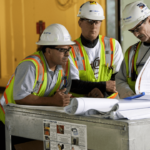COVID 19: How to protect employees (7 Essential tips)
Operating a business in these uncertain times is very challenging, and you need the best and most up to date information to make an informed decision.
After all, your livelihood could be on the line.
The UK government has also made it clear that they want you to make every possible effort to keep working – to keep the economy running and keep people employed. As such, you will need to consider a number of things relating to health and safety.
So what do you need to know to keep everyone safe from COVID at work and keep your business compliant?
Below are my top 7 essential tips taken from government sources to help protect employees.
1. Social distancing at work
By now, we all know we should be socially distancing 2 meters apart. However, whilst this still remains a core government recommendation, the guidance has since acknowledged this may not always be possible. Therefore, in these circumstances, you can socially distance 1 meter apart – as long as you factor in some additional controls. Controls you can consider are;
- The use of face coverings
- Limiting the number of people in an area
- Improving the ventilation, keeping windows and doors open
- Altering/adapting seating, so people are not sat next to, or directly opposite each other
- Use barriers and screens to limit exposure where possible
- Make sure there is signage guiding and informing your employees
- Limit face to face contact time
When thinking about your work environment you also need to think about how you can help people socially distance when using common areas such as kitchens, staff rooms and toilet facilities. How are you going to manage the flow of employees in corridors/walkways for example? Can you implement a one way system? Is there a separate entrance and exit point you can use? What signage can you use to direct employees in keeping the recommended distance? These are all valid questions to ask yourself, and make sure you do! The HSE can and will issue fines for non-compliance.
The great news is you can find lots of free examples here of sector/ industry guidance on social distancing. That includes sectors like retail, construction, outdoors, manufacturing and much more.
2. Shielding employees who are most at risk
Public Health England wants you to shield at-risk employees. If you’re not sure who counts as ‘at-risk,’ ask your employees if they have been advised by their doctor that they are clinically extremely vulnerable. That means you don’t need to guess who is and who isn’t. It is also important you consult with your employees to let them know you value their input, safety and well-being!
To protect your employees, I would advise that you carry-out a vulnerability risk assessment. This should include individuals that are also deemed to be at a ‘higher risk’. According to Public Health England, additional groups are;
- Older males
- Individuals with high blood pressure
- Pregnant women
- Individuals with health conditions such as diabetes
- Employees from Asian, black and minority ethnic groups – BAME backgrounds
When it comes to supporting extremely clinically vulnerable employees it is important you make every effort to help them work from home. If this is not possible, you need to continuously review and assess the risks, doing everything ‘reasonably practicable’ to protect them from harm.
3. Hand washing, cleaning and hygiene
So, lets talk hygiene…
Preventing the spread of Coronavirus from coughing/sneezing and transmission via surfaces is paramount to protecting your employees! There are several things you can do to help with this;
- Provide adequate hand washing/sanitising stations and facilities
- Provide signs and posters to remind employees to wash/sanitise their hands regularly
- Clean the workplace and workstations frequently
- Identify regular touch points and frequently clean them
- Use disinfectant, fog, mist, vapour or ultraviolet systems to clean your premises
- Discourage hot desking where possible
- Where possible reduce peoples contact with surfaces and objects
- Clean commercial vehicles regularly
4. Display Health and Safety Signage
COVID 19 health and safety signage are now in high demand, but before you start google searching ‘COVID health and safety signs’ I want to go over some basic sign tips.
COVID 19 Health and Safety Law Poster:
The HSE expects you to have this poster displayed in your workplace to show you have followed the COVID industry guidance.
Mandatory hand-washing signage:
You’ll want to display mandatory hand washing and sanitation signage in and around toilets, washing facilities, and entrances, to remind people to keep cleaning their hands.
Mandatory social distancing signage
Install wall, floor and door signage showing people how and when to maintain the 2 metre distancing guidelines.
Out of bounds Areas:
You’ll also want to consider signage to indicate areas that are now out of bounds (e.g., lifts, seating, viewing, galley areas).
Hazard Warning Tape:
Don’t forget warning tape, which you can place at the top of stairs and across doors, to help provide a physical barrier.
5. Let employees work from home
The advice is still the same. Try and conduct as much of your business from home as you can to help protect employees.
You can still host meetings, interviews or training days online, and there are plenty of low-cost technology solutions so people can continue work from home. Notwithstanding this, it is important you consult with your employees, conduct a DSE assessment and ensure long-term homeworkers have the correct equipment to do their job. And, when it comes to supporting your homeworkers, it is a good idea to have a system or procedure in place to check in on their well-being! I would encourage you to contact employees every week for a one-to-one about their work-life balance.
If contact is poor, your employees can feel isolated, affecting their stress levels and mental health.
With such amazing advances in technology there are some great ways to work remotely. And, if you haven’t tried lots of different tools yet, here are my crucial tech recommendations:
Video calls: Zoom, WebEx, WhatsApp, and Microsoft Teams
Project Management: Monday.com, Trello
Collaboration and Messaging: Microsoft Teams, Slack
Training: Microsoft Teams
Remote Audits: WhatsApp, Zoom and Microsoft Teams
6. Cut Travel
You may need employees to visit the office or meet a client so you can close a new contract or deliver a service.
Unless that employee is showing COVID-19 symptoms, or self-isolating, then its okay to approve travel.
However, you should still try to use technology and social distancing wherever possible.
Remember, your business should keep operating.
7. Risk Assessment: Communication & Engagement
Often, employees feel that they don’t have a voice, and in times of crisis, people feel extra anxious and helpless. This means that your employees may show signs of the stress response: fight, flight or freeze.
With extreme uncertainty surrounding COVID-19, you need to make sure they feel able to speak about their worries. I recommend thinking carefully about how best to communicate with your employees.
Rather than just stating the new rules of working, it’s much better to get them involved by asking for volunteers to help develop practical procedures to protect everyone from the spread of the virus.
The good news is, there now sector-specific guidance documents to help you get started.
Here’s a list of items you can discuss and develop with your employees:
- Where to display the COVID Health and Safety Poster
- COVID Risk Assessments
- Procedures for COVID-19 controls
- Training packs/ briefings
- Signage and posters
- Internal Communication packs
- Working from home rules
- Cleaning regimes
- Well-being and support
- How to maintain standards
I wouldn’t just email people. Host a video call so they can see how passionate you are about doing the right thing. And don’t forget once you have completed your risk assessment, the government now wants you to publish the results on your website.
Conclusion
That’s my last tip for now. I hope that focusing on these 7 areas has helped you feel able to reassure all your employees that you want to protect their health, well-being and safety.
Ultimately if you want to get your business back up and running and to remain compliant keep checking the links above.
If you need help with your COVID-19 risk assessment, please email hello@prosafetymanagement.co.uk for a free consultation.
Do you have any thoughts or ideas that can help protect employees? Let us know what your teams have been doing to keep people’s spirits high! Leave a comment so we can help other people in this time of need.
Comments (2)
Comments are closed.






Julie Sykes
May 27, 2020A really useful post, thanks Alex. I especially like the point about getting employees’ buy-in and engagement.
Alex Burbidge
July 15, 2020Hi Julie, thanks I really feel that engagement is missed and there’s plenty of COVID-19 guidance that needs input from employees on the best ways to implement these.